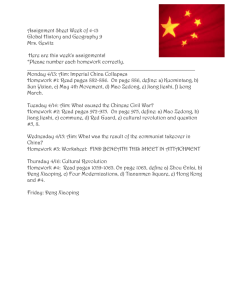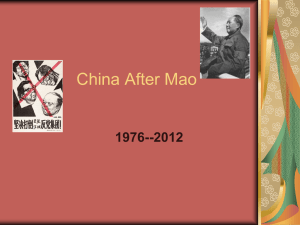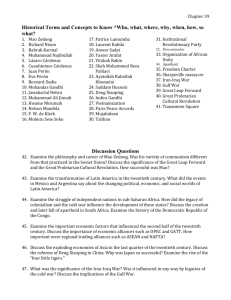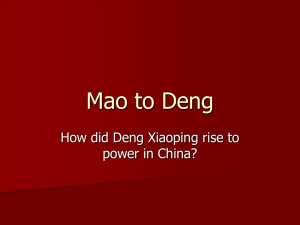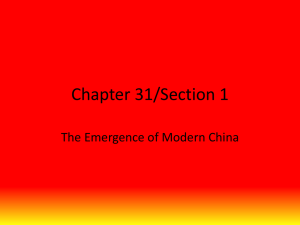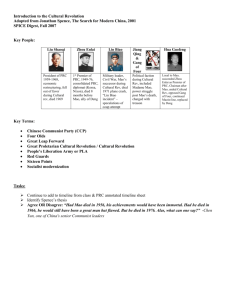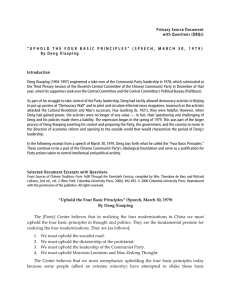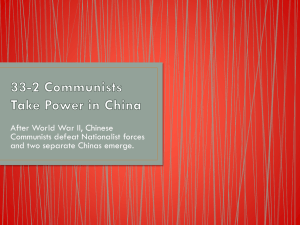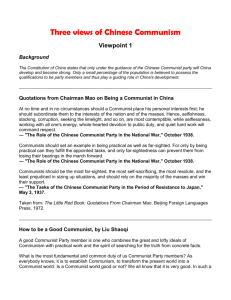Communism in China
advertisement
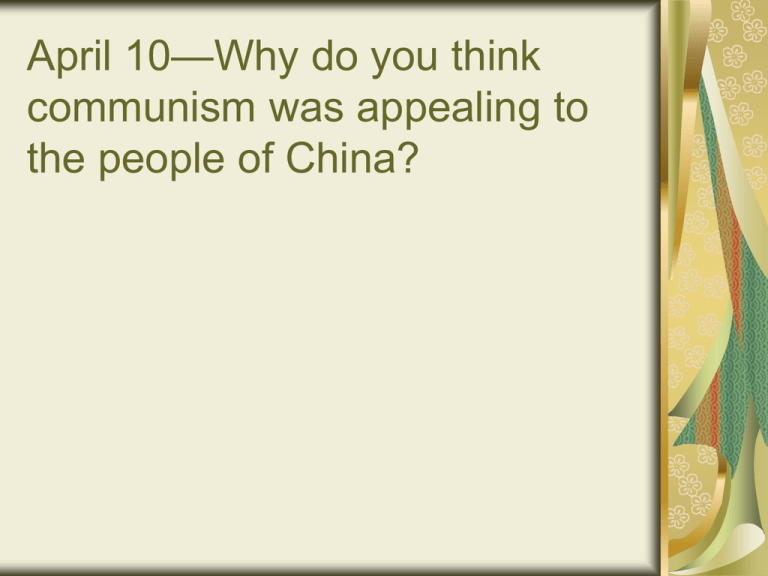
April 10—Why do you think communism was appealing to the people of China? Communism in China IB Objectives Spread of Cold War outside of Europe the struggle for power following the death of Mao Zedong (Mao Tse-tung), Hua Guofeng (Hua Kuo-feng), the re-emergence of Deng Xiaoping (Teng Hsiao-p’ing) and the defeat of the Gang of Four IB Objectives China under Deng Xiaoping: economic policies and the Four Modernizations China under Deng Xiaoping: political changes, and their limits, culminating in Tiananmen Square Key Terms Sun Yat-sen General Yuan Shigai Chiang Kai-shek Mao Zedong The Long March The Great Leap Forward The Great Proletarian Cultural Revolution Deng Xiaoping Lecture Outline I. The Communist Victory in China A. Rise of the Nationalists B. The Long March C. The Impact of WWII D. US intervention E. China Under Mao F. China after Mao Rise of the Nationalists In 1908, Empress Dowager Ci Xi died and her son died one day before her. The throne was left to the infant Henry Pu Yi. Henry Pu Yi was overthrown by Sun Yatsen, the founder of the Nationalist Party, in October 1911. General Yuan Shigai became president of the Chinese Republic. Rise of the Nationalists Yuan ruled in a traditional manner and even tried to set up a new imperial dynasty. He used murder and terror to destroy the new democratic institutions. Yuan died in 1916 and was succeeded by one of his officers. Rise of the Nationalists China slipped into civil war and military warlords seized power in the provinces. The Chinese Communist Party was created in 1921 in Shanghai by a group young radicals from Beijing University. In 1923, under the leadership of Chiang Kai-shek (Sun Yat-sen dies in 1925) the Nationalist Party formed an uneasy alliance with the Communists, led by Mao Zedong, in order to crush the warlords and unite the country. Rise of the Nationalists The Nationalists consolidated their power in 1928, and established the capital of China at Nanking. In 1927 Chiang Kai-shek turned on the Communists. The Long March In 1933 the main Communist army broke out of a Nationalist encirclement and marched 6,000 miles in 12 months to a remote region on the northwestern border. Of the 300,000 people who began the Long March, less than half reached the final destination. The Long March Once there Mao built up his forces and won the support of the local peasants by redistributing farm land. Communist Victory in China After 1931 the Nationalist government completely ignored land reform and the terrible poverty of the Chinese peasant. Chinese peasants paid about ½ of their crops to their landlords in rent. 50% of the land was owned by only 4% of the families. . Communist Victory in China Eggs and meat accounted for only 2% of the food peasants consumed. Japanese aggression in the 1930s was the most important factor in Mao Zedong’s rise to power. Chinese suffered an estimated 11 million civilian and military deaths from 1931 to 1945 in their war with Japan. Impact of WWII The war enabled the Communists, aided by their temporary “united front” alliance against the Japanese with the Nationalists, to build up their strength in guerrilla bases in the countryside behind Japanese lines. By the end of the war the Communists controlled large parts of China. Impact of WWII In 1946 the US sent General George Marshall to China to resolve the conflict and the 2 parties signed a truce and reached a general agreement on the sharing of power. When the truce expired in July 1946, the fighting resumed. US Intervention During 1945-1948 Chiang received more than $3 billion in US aid. US imports were responsible for 51% of all Chinese imports (as opposed to 22 percent in 1936 and 57 % of all exports (compared to 19% in 1936). US Intervention In September 1947 a US mission to China reported that the Nationalist’s “reactionary leadership, repression, and corruption” had destroyed the Chinese people’s confidence in Chiang’s government. Communist Victory in China The huge influx of US $ caused inflation to grip the country and China’s money became nearly worthless. In December 1949 the Communists defeated the Nationalists. Chiang and 1 million of his followers fled to the island of Taiwan under US protection. China Under Mao In 1955 Mao began collectivization and most industry and commerce was nationalized. In 1958 Mao began the Great Leap Forward. Bad planning and bad weather drove food production down. At least 16 million starved to death, and in 1960 the government began breaking up the communes into collectives and some private plots. China Under Mao In 1957 Mao admitted that 800,000 “class enemies” had been executed between 1949 and 1954. The Cultural Revolution In 1966 he launched the Great Proletarian Cultural Revolution which was led by the Red Guards. Its goal was to eliminate the “4 Olds”—old ideas, old culture, old customs, and old habits. The End of Mao In September 1976, Mao died at the age of 82. A group of practical-minded reformers led by Deng Xiaoping seized power and ended the Cultural Revolution. Deng Xiaoping called for the 4 Modernizations—new policies in industry, agriculture, technology, and defense. Deng Xiaoping His policies allowed peasants to lease land and sell crops or goods they made on the private market. Industrial output skyrocketed. During the 1980s, per capita income doubled. After Deng’s death in 1997, his successors followed his policies. Deng Xiaoping Many felt Deng’s reforms left out a key part of modernization— democracy. 1980s=rising inflation and government corruption May 1989 student protesters began to call for party leaders to resign. Tiananmen Square 100,000 students occupied the square Deng believed protesters wanted to end communism. June 4, 1989 Deng ordered troops and tanks into the square. 500-2,000 were killed and many more injured.
